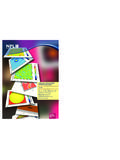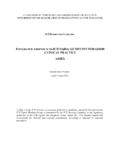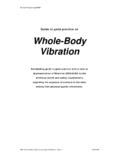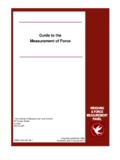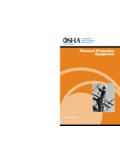Transcription of Work-Integrated Learning: Good Practice Guide
1 HE Monitor 2011 Council on Higher EducationWork- integrated Learning: good Practice Guide Work-Integrated learning : good Practice guIdEHE Monitor No. 12 August 2011 th e cHE is an independent statutory body established by the Higher Education Act, no. 101 of 1997. the cHE is the Quality council for Higher Education, advises the Minister of Education and training on all higher education issues and is responsible for quality assurance and promotion through the Higher Education Quality committee. Published by the council on Higher Education (cHE) in 20111 Quintin Brand StreetPersequor technoparkBrummeriaPretoriaSouth Africa+27 12 349 on behalf of the cHE by Iecommunicationstoscana, IL Villagio, 5 de Havilland crescentPersequor ParkBrummeriaPretoria+27 12 349 council on Higher Education, Pretoria, 2011 All rights reserved. Material from this publication may not be reproduced without the cHE s 978-1-919856-81-0 tABLE oF coNtENtS ForEWord AckNoWLEdgEMENtS 1 INtroductIoN ANd BAckgrouNd Purpose and overview of the Guide Who is this Guide for?
2 Defining Work-Integrated learning Work-Integrated student learning Work-Integrated learning in South African higher education Early understandings and approaches to Work-Integrated learning challenges to traditional practices 2 A coNcEPtuAL FrAMEWork For Work-Integrated learning Science, higher education and professional Practice : three interrelated fields Professional education: looking both ways crossing knowledge boundaries recontextualising academic knowledge in the world of work recontextualising workplace knowledge in the academic curriculum learning in and across the different knowledge fields 3 currIcuLuM dESIgN ANd dEVELoPMENt For Work-Integrated learning Introduction to curriculum curriculum development in Work-Integrated learning curriculum planning curricular modalities work -directed theoretical learning Problem-based learning Project-based learning Workplace learning A Work-Integrated learning typology Implications for Work-Integrated learning at different HEQF levels Work-Integrated learning in a 1-year certificate (HEQF Level 5) Work-Integrated learning in a 2-year advanced certificate (HEQF Level 6) 1233446677889101011111313131416161718192 1222323 Pages Work-Integrated learning in a 3-year diploma/Bachelor s degree (HEQF Level 7)
3 Work-Integrated learning in a 4-year professional Bachelor s degree (HEQF Level 8) Work-Integrated learning in a Master s degree (HEQF level 9) Work-Integrated learning in a doctoral degree (HEQF level 10) the formal accreditation of Work-Integrated learning the accreditation of work -directed theoretical learning the accreditation of problem-based learning the accreditation of project-based learning the accreditation of workplace learning recognition of prior learning in a Work-Integrated learning curriculum 4 tEAcHINg ANd learning Work-Integrated learning teaching for transfer Student learning in Work-Integrated learning Academic and workplace collaboration in teaching and learning Pedagogical approaches for different WIL curricular modalities work -directed theoretical learning Problem-based learning Project-based learning Workplace learning 5 ASSESSMENt oF/For Work-Integrated learning Principles of Work-Integrated learning Formative assessment for Work-Integrated learning Summative assessment of Work-Integrated learning developing assessment tasks demonstrating knowledge and
4 Understanding thinking critically and making judgements Solving problems Performing procedures and demonstrating techniques designing, creating and performing Managing and developing oneself Accessing and managing information Assessment criteria for Work-Integrated learning Assessment for Work-Integrated learning curricular modalities work -directed theoretical learning Problem-based learning Project-based learning Workplace learning 6 PArtNErSHIPS For Work-Integrated learning Introduction to partnerships for Work-Integrated learning Partnerships for the different Work-Integrated learning curricular modalities Partnerships for work -directed theoretical learning 2424252627272727272931313232323233363741 4142434444444445454545454646474848515151 51 Partnerships for problem-based learning Partnerships for project-based learning Partnerships for workplace learning Managing partnerships Initiating partnerships Implementing partnerships Maintaining partnerships reflection and evaluation 7 MANAgINg Work-Integrated learning
5 Introduction to the management of Work-Integrated learning Managing Work-Integrated learning : the institutional level Managing Work-Integrated learning : the departmental level work -directed theoretical learning Problem-based learning Project-based learning Workplace learning Managing resources for Work-Integrated learning Financial resources Staff resources Physical resources 8 coNcLuSIoN BIBLIogrAPHY gLoSSArY oF tErMS52545556565757575858586060606162636 36464656671 ForEWordthe Higher Education Quality committee (HEQc) in 2002, in the context of developing the national quality assurance system, established a project to foreground the core function of teaching and learning in the context of the restructuring of higher education. Subsequently it published the Improving teaching and learning resource (March 2005) as part of its prioritisation of quality issues in teaching and learning . Since then, there have been a number of teaching and learning related publications that have served to increase the level of national and institutional debates on the conceptualisation, quality and Practice of teaching and learning .
6 Examples of such publications include, Service- learning in the curriculum: A resource for Higher Education Institutions (2006), A good Practice Guide and Self-evaluation Instruments for Managing the Quality of Service- learning (2006), Higher Education Monitor: A case for Improving teaching and learning in South African Higher Education (2007), case studies on dealing with pipeline students within their respective institutions (2007), Service- learning in the disciplines: Lessons from the Field (2008), and Higher Education Monitor: Access and throughput in South African Higher Education - three case studies (2010).A central feature of the HEQc s approach since its inception has been to initiate and facilitate quality-related capacity development activities in a collaborative manner across a range of areas in higher education, including the Practice of teaching and learning . the quality promotion and capacity development activities for the South African higher education sector have included the conducting of large dedicated projects in selected areas, workshops, training sessions, seminars, and publication, Work-Integrated learning : A Guide for Higher Education Institutions, is intended to assist those involved in programme development and in the curriculum development and adaptation required by the Higher Education Qualifications Framework (october 2007).
7 It also aims to prompt other academics who are involved in teaching to consider the educational purpose and role of Work-Integrated learning in teaching and learning . As the authors argue, university teachers should be concerned to ensure that the students that graduate from their programmes are prepared for the world in which they will live and work . the publication provides a theoretical foundation for Work-Integrated learning while making use of a large number of local and international case studies for illustration and example. the authors, contributors and reviewers are thanked for producing this publication within a short time-frame. the comprehensiveness of its content and the care taken by the authors to make the topics accessible to the reader is greatly appreciated. A word of appreciation is extended to Ms Bella Sattar who initially took charge of the project, and to Professor chris Winberg who subsequently coordinated the writing of the manuscript to its completion.
8 The Programmes and Qualifications committee of the South African technology Network is thanked for the initial idea to produce this publication. the cHE hereby expresses its gratitude to Professor Anthony Staak, of the South African technology Network, for overseeing the submission of the draft Mark HayExecutive director August 2011 Work-Integrated learning : good Practice guide1 Work-Integrated learning : good Practice Guide 2 AckNoWLEdgEMENtSAuthors: Professor christine Winberg (co-ordinator), Associate Professor Penelope Engel-Hills, dr James garraway and Associate Professor cecila Jacobs (cape Peninsula university of technology).Contributors: Ms Marianne Bester (cape Peninsula university of technology), Mr riaan Bouwer (central university of technology), Professor Ansu Erasmus (tshwane university of technology), Mr Alpheus Maphosa (Vaal university of technology), dr Joyce Nduna (cape Peninsula university of technology), Ms Fundiswa Nofemala (cape Peninsula university of technology), Mr Julian Vooght (durban university of technology) and dr Marius Wessels (tshwane university of technology).
9 Reviewers: dr Jeanne gamble (university of cape town) and dr Matete Madiba (university of Pretoria). Work-Integrated learning : good Practice Guide3cH APtEr oNEIN troductIoN ANd Purpose and overview of the guideth ere is considerable interest, both in South Africa and internationally, in curricular and pedagogical reform that will both support students from diverse backgrounds and prepare them for the challenges of the global economy and responsible citizenship. governments around the world are concerned that universities make the highest possible contribution to students graduateness in various forms. Programmes that promote graduates successful integration into the world of work and that enable graduates to make meaningful contributions in contexts of development, require innovative curricular, teaching, learning and assessment practices . South African universities commitment to positive graduate outcomes, global citizenship and community engagement add extra dimensions to the importance of WIL in curriculum design and development, as a process of reciprocal involvement that can benefit students, professions, workplaces and communities.
10 This Guide to Work-Integrated learning (WIL) was produced to assist academic staff to address these issues in their different programmes and disciplines. the Guide was produced in the context of the promulgation of the Higher Education QualificationsFramework (HEQF) and processes of national curriculum review. the HEQF proposes six higher education levels (Levels 5 10), with different qualifications requiring appropriate credits at different levels. thus the Guide also intends to assist academic staff, particularly those where existing programmes are undergoing revision, in developing appropriate forms of WIL for different levels of the HEQF. It is thus the purpose of this Improving teaching and learning (ItL) resource to provide university teachers with a Guide to planning, implementing and managing good WIL Practice . to this end the Guide is divided into seven sections: 1) Introduction to WIL, 2) A conceptual framework for WIL, 3) curriculum design and development for WIL, 4) teaching and learning for WIL, 5) Assessment for/of WIL, 6) Partnerships for WIL, and 7) the management of WIL.












